‘Old Speckled Hen’ – Maintaining the Sense of Fun Inspired by MGs at Abingdon
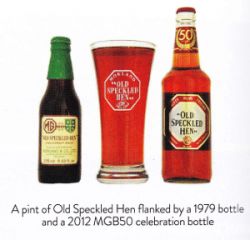
 In addition to the recognised day-to-day duties of what would now be a human resources department, the personnel and training section of the personnel department at MG’s Abingdon Factory was also responsible for organising factory tours, local press relations and maintaining links to MG enthusiasts.
In addition to the recognised day-to-day duties of what would now be a human resources department, the personnel and training section of the personnel department at MG’s Abingdon Factory was also responsible for organising factory tours, local press relations and maintaining links to MG enthusiasts.
For those visiting the factory a variety of souvenirs were on sale at the personnel department counter. The souvenirs had been funded by the factory after the senior management team had been persuaded to provide £1,000 to purchase some initial stock. The money was provided on the understanding that it was to be considered an interest-free loan that would have to be repaid and the souvenirs would become self-financing.
Our first major purchase was 600 T-shirts, which were in brown and cream. We had produced a quick design of a brown MG Octagon on a cream T-shirt and a cream MG Octagon on a brown T-shirt. Quotes had been obtained from a number of potential suppliers, some of which had been over £3 per shirt and could not be funded, while one Portuguese supplier quoted something like 26p but we had no idea of the quality, how the supply chain would work or whether this was a loss leader.

We therefore went with a local supplier who had visited the factory and could personally deliver the T-shirts to be paid cash on delivery. The first T-shirts were delivered just before lunch on a Friday, and after excitedly opening the boxes a tannoy announcement was made to the workforce. It told them that MG t-shirts were for sale in the personnel department at £1.40 each. We had already made the decision to sell the T-shirts at £1.65 with a 25p discount for employees.
By the time work finished on the Friday the £600 we had taken from the finance department in the morning had been largely repaid. The T-shirts were the first of a range of items, all of which had been designed within the personnel and training department and were unique to the factory.
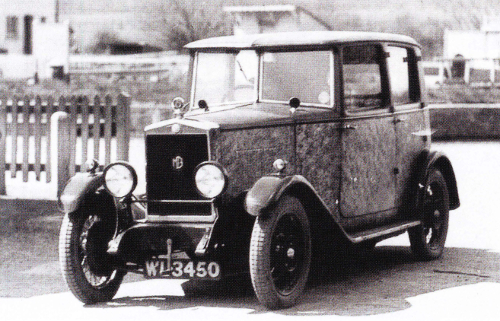
It naturally followed that the department would be responsible for any Jubilee memorabilia, and a list of possible items was presented to the senior managers for their consideration. I had the idea of an octagonal MG beer mat whilst waiting for food at The White Hart in Fyfield, where l thought that an octagonal beer mat advertising MG Cars would be so out of place amongst beer adverts and ‘don’t drink and drive’ messages that it was bound to create some discussion. A beer was added to the idea when presenting the Jubilee items to senior management, and although the beer was given a positive reception we were not asked to progress it further.
The personnel and training department had taken on a range of responsibilities in preparation for the Jubilee, so l gave no more thought to the beer until I received a call from Tony Day who was at the BL Cars Haseley Manor training centre, just outside Warwick. It was around 4.15pm and his message was that he had forgotten to tell me that the Plant Director, Peter Frearson, and Personnel Manager, Pat Whyton, were expected at Morland’s Brewery first thing the following morning.
The brewery expected a beer label design for the anniversary beer. After our initial presentation of ideas Peter Frearson had contacted his opposite number at the brewery and the production of a beer had been agreed.
We ceased work at 4.30pm, so by the time I had finished my conversation with Tony I would normally have been preparing to leave work. Having put the phone down I gathered a number of books about MGs, did some research on what needed to be on a beer label and got something to eat. My first scribbles were to reflect the factory’s anniversary, and I initially worked with such headings as ‘Anniversary Ale’ and ‘Jubilee Brew’.
The word golden was appropriate for a 50th anniversary and I felt the word golden also seemed appropriate to a beer. The problem was that the word golden seemed cumbersome when attached to any of the anniversary phrases. Asking for “A bottle of ‘MG Golden Anniversary Ale ” at a bar felt too much of a mouthful. It was with some personal amusement when just over 30 years later Greene King introduced ‘Old Golden Hen’ to their Morland’s coop.
From the moment I had put the phone down and collected the MG books together, my aim had been to find a suitable name with an MG connection. The use of a racing team name had real attractions. Amongst my first attempts I used the racing teams of the ‘Three Musketeers’ and ‘Cream Crackers’. The name Cream Cracker rolls off the tongue very satisfyingly, and as l scribbled away I could envisage a customer asking for a bottle of ‘Cream Cracker’.
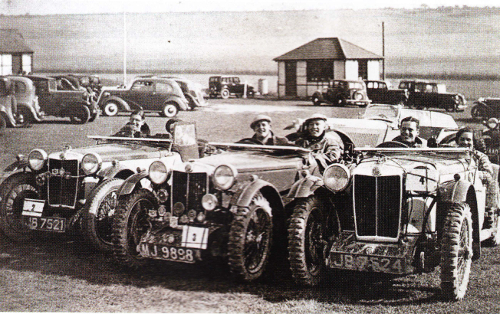
The problem for me was the word cream, I had grown up where grandmothers primarily drank milk stout or cream stout and this didn’t match the beer being produced, or the MG customer base. I was more attracted to the idea of calling the beer after the ‘Three Musketeers’ racing team and spent some time designing a label entitled ‘Three Musketeers’. I had some concern that the title was very male-oriented and my thoughts went to whether this could be a beer targeted at the men and a perhaps slightly different version for women.
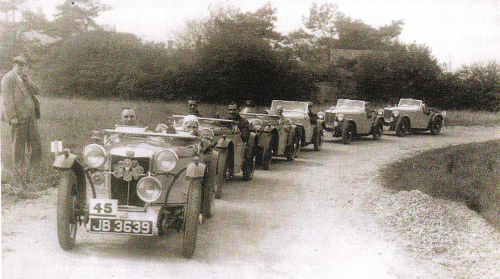
A very successful TV drama entitled ‘Rock Follies’, following the fortunes of an all-female group called ‘Little Ladies’, encouraged me to find out if there was a female racing team with an appropriate name. The first I found was the all-female team established by George Eyston called ‘Dancing Daughters’ which I recall couldn’t envisage as a beer name.
With time seeming to fly past, common sense said that it was not productive to look for an appropriate female team name, as to make two beers would almost certainly be rejected since it would mean twice the investment and twice the capital tied up in stock. I continued from a scribble to a basic design for the ‘Three Musketeers’ name before deciding I really didn’t like it, as the name suggested a musky, lifeless beer.
Returning to the books, I was interested by a reference to the “owld speckly un” a factory demonstrator/runabout in Oxford prior to the Abingdon move. I had read elsewhere that this car had been called the hen by some who had misunderstood the Oxford dialect and the phrase ‘speckly hen’ seemed a lively phrase. In my head I could see the colour of a speckly hen being similar to the beer. Although I recognised that the word ‘owld’ signified affection for the car more than its age, the word ‘old’ had an attraction.
We had been working with Leonia, the company responsible for MG sales in North America. They were bringing several hundred of their sales staff to Britain for the Jubilee and I thought the word ‘old’ would give the beer a kind of provenance that would appeal to this group. Changing the word ‘speckly’ to ‘speckled’ reinforced the idea of age and I quickly did a rough sketch of a beer label with the words ‘Old Speckled Hen’ on it.
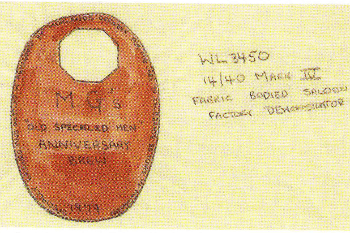
I had left the design in my bag and decided it would have more impact if I didn’t show it to him until he asked for it. At around 9.20am he took a phone call and came over to ask for the design, explaining that Peter Frearson was in Pat Whyton’s office ready to go to the brewery for a 9.30am meeting. I got the design out for Tony expecting a positive reaction, but what he asked was: “OK, where is the real one?”
After explaining that it was the real one and that there were no alternative designs, he took the design on the basis that it was only a concept design to have the beer given a name connected to MG history rather than just one saying MG Jubilee Beer or similar. I gave a quick briefing on where ‘Old Speckled Hen’ came from and it was clear that I had no support.
Forced by circumstances to present the ‘Old Speckled Hen’ beer label to the Directors and marketing team at the brewery, not only was the concept accepted but the name and beer label was enthusiastically received. By the end of the meeting it had not only been agreed that the beer would be produced under the ‘Old Speckled Hen’ name but that Morlands would arrange for a production design of the label and market the beer in some of their public houses.

It was also agreed that a beer mat would be produced with a copy of the label on one side and text of approximately 40 words from MG and another 40 from Morlands on the reverse. This text would reflect the history of the two organisations. I still wanted an octagonal beer mat but this was not possible as there was no octagonal cutter available.
Back at the factory Pat Whyton was clearly upset that the name had been adopted by the brewery, and was unhappy with Tony Day and myself. At the time I thought it was just that he hated the name, but months later I realised he was concerned that the ‘name’ had been derived from a factory runabout and he was nervous that the press and other media would negatively portray the car. I don’t believe he ever liked the name, but had the car been a record breaker he would have been more relaxed about it.
Following this uncomfy meeting Tony Day instructed me that I should make sure the 40 words on the beer mat justified the use of the name. After several false starts and a final discussion with Tony, I sent the following wording to the brewery:
“Cecil Kimber, founder of MG, brought MGs fabric-covered car, the ‘Old Speckled Hen’, to the Abingdon factory in 1929. During the last 50 years over one million sports cars have been produced by MG – around 75% being exported. ”
I believe that it is the responsibility of each generation to accurately record events for future generations, but when the sharks are chasing your tail, tomorrow is not at the forefront of your thinking. In this short piece I had said that the car’s name was Old Speckled Hen and that the car had been at Abingdon. While the original name was recorded elsewhere, I had no evidence that the car had ever been transferred to Abingdon. It seemed a reasonable assumption that the car had come with the rest of the factory equipment, and a few months later this was confirmed by H M Charles, the designer of the original Midget, when he returned to the factory for a nostalgic visit.
Under normal circumstances the ‘Old Speckled Hen’ name would not exist. Had Tony Day remembered that we needed to produce something before that final evening, and had he, Peter Frearson, or Pat Whyton asked to see the beer label more than a few minutes before the meeting at the brewery, they would have insisted on a label with a different, less memorable name.
From the start, the beer was represented by cartoon hens (later a fox) and the sense of fun around the name quashed fears of a negative press. The senior managers at MG got behind the name and sales in the area meant that the brewery had to increase the supply, starting a process, which has preserved the Morland name and maintained the sense of fun inspired by MG cars.
This article was written by Ian Williams, Personnel and Training Department of the Abingdon MG Car factory. NAMGAR would like to thank the Editor of Safety Fast! magazine, Andy Knot, for providing his permission to reproduce this article.

